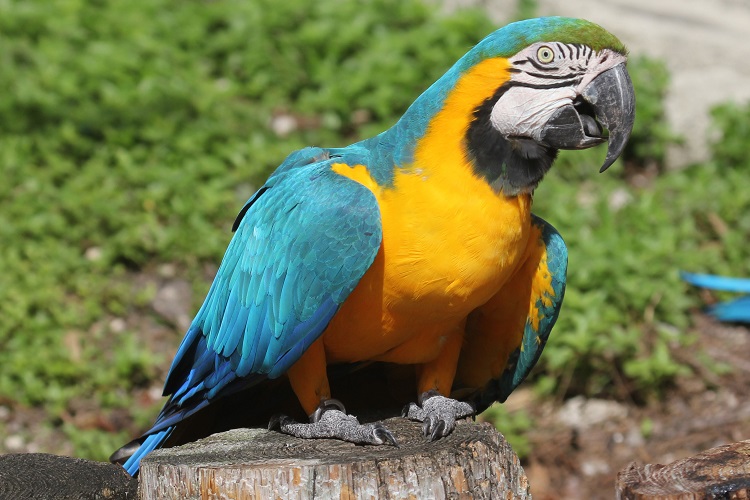These colorful birds, whose natural habit is the rainforests and open grasslands of Central and South America, Mexico, and the Caribbean, are now found in many parts of the world where they are kept as domestic pets.
Curious birds by nature, they are playful with active personalities to match their size.
But this is no species of bird to be trifled with. Macaws, although popular pets, require an experienced bird owner, preferably with previous experience and know-how on how to deal with and raise these demanding birds.
Pleasing on the eye, macaws explode with color and magnificence until they throw a tantrum and produce that ear-splitting scream they are renowned for.
In this article, we will look at the macaw and delve into the background of this fascinating bird.
About the Macaw Bird
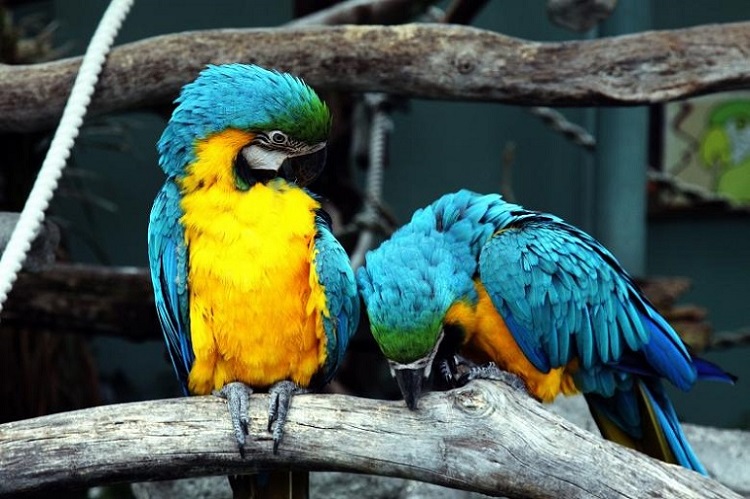
As king-sized members of the parrot family, the macaw is hard to miss with its instantly recognizable vibrant, colorful plumage, large hooked beak, and ear-piercing squawks.
Not only colorful but entertaining, these large, powerful birds are outgoing and friendly, with each species having different personalities and likes and dislikes.
In fact, the largest of its species, the Hyacinth macaw, is known as the ‘gentle giant” due to its affectionate and sweet nature, especially if it was a hand-fed baby.
While in contrast, the Scarlet macaw tends to be more aggressive and infamous for getting meaner with age.
Highly emotional animals, macaws can give in to bouts of jealousy both in the wild and as domestic birds.
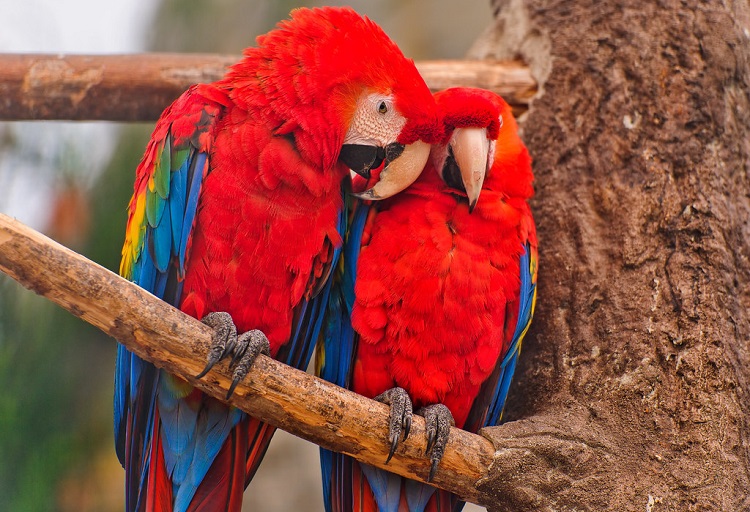
If brought up from a young age and properly socialized, macaws, although challenging to care for, can make loyal companions for the right owners.
You can also check the your bird age in human years by using our calculator.
In fact, if not raised in the right environment and socialized correctly, these highly intelligent birds can become vicious, neurotic, and aggressive.
Perhaps one of the traits macaws are best known for is lunging at people, especially strangers. But this lunging behavior experts believe is rarely about aggression.
For the savvy macaw has learned that this behavior elicits a certain response in humans and then uses it to control and test reactions and uses it as a game.

What Does a Macaw Look Like? (Physical Appearance)
As members of the parrot family, macaws are present with typical parrot features such as a large, curved beak, a dry, scaly tongue with a bone inside, agile, strong claws with a zygodactyl foot, and of course, their trademark feathers in bright, bold colors.
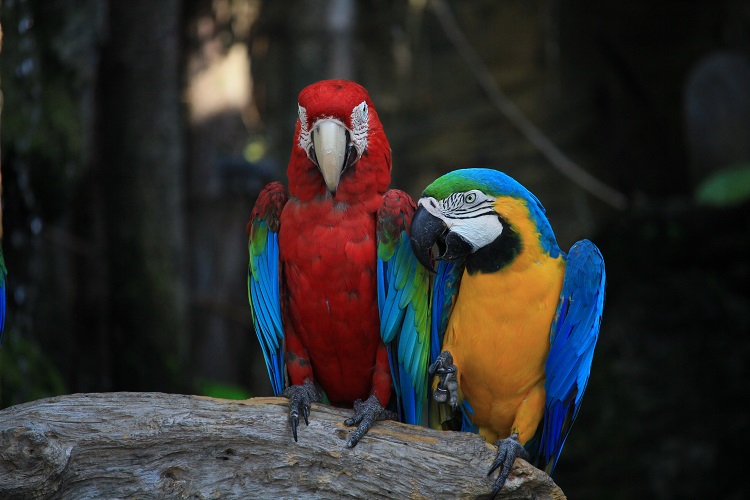
How Big Is a Macaw?
What sets the macaw apart from most of its parrot cousins is its sheer size, for this species of bird is a king-sized member of the parrot family. In fact, the largest species is the Hyacinth macaw which comes in at 39.4 inches and weighs up to 3.7 pounds.
While the smallest species of bird, also referred to as mini-macaws, is the Red-shouldered macaw at 11.8 inches, weighing up to 5.9 ounces.
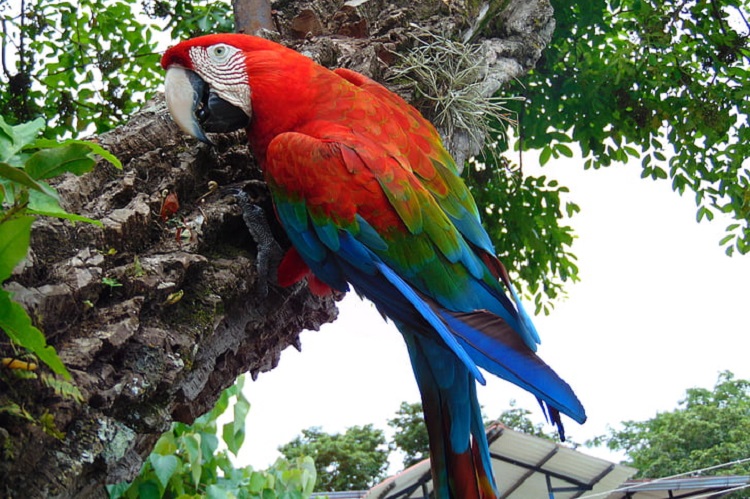
What Makes a Macaw?
In addition to their larger beaks and longer tails, the characteristic that distinguishes macaws from other parrot family members is their light-colored or bare facial patch.
The macaw’s facial feather pattern varies in size and shape according to the different macaw species and acts as the bird’s unique identifying fingerprint.
Where Are Macaws Located?
Macaws are native to Mexico in North America, South America, Central America, and the Caribbean.
Where Are Macaws From? (Origin)
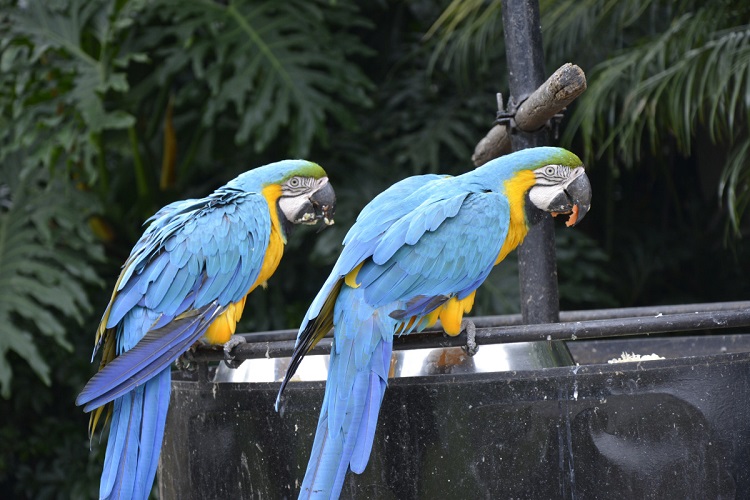
Macaws are considered neotropical or New World parrots. Europeans came to know of the bird when Columbus remarked upon them in his journal in 1492.
In fact, cave paintings of macaws have been found in Brazil, dating back some 5,000 years.
And although relatively few fossils of modern parrots have been found, the ones that have are those of macaws and parakeets from the tribe Arini, dating back some 16 million years ago.
What Is a Macaw’s Typical Habitat?
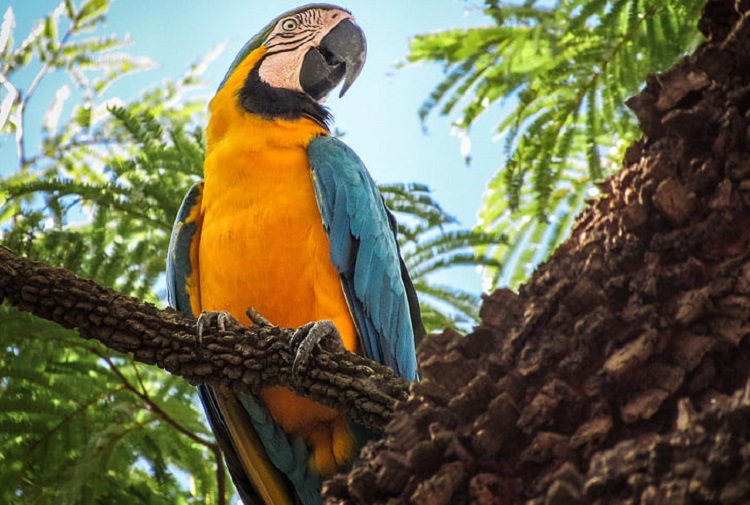
While most species of macaws are associated with rainforests such as the Amazon or the rainforests along Mexico’s southeastern parts, there are some species that prefer savannah-like or woodland habitats.
Macaw Population
Due to deforestation activities, poaching, and the overzealous wildlife trade, macaw numbers are in decline.
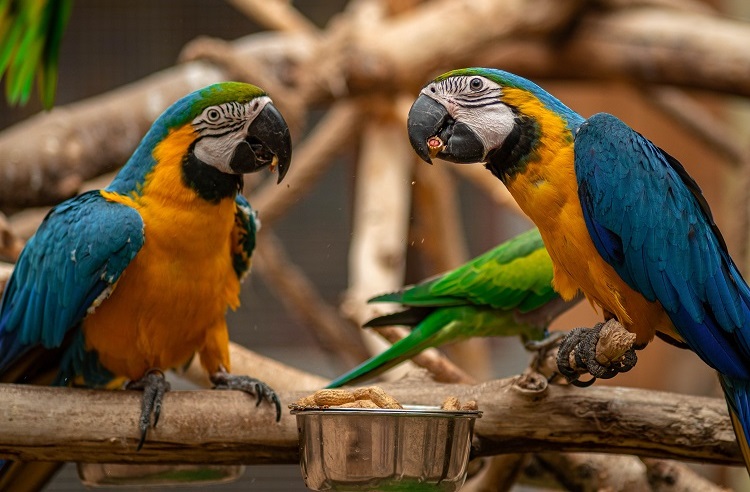
According to the ICUN Red list, between 20,000 to 50,000 of the Scarlet macaws exist today, while the Macaw Recovery Network puts the Great Green macaw numbers between 500 to 1000.
Additionally, the Blue-throated macaw numbers are estimated to be somewhere between 350 to 500 individuals today, while the largest of the species, the Hyacinth macaw, is estimated to be about 2,000 to 6,500 today.
Macaw Species
Macaws fall under the family Psittacidae (Parrots), of which there are six genera and 17 species.
Interestingly enough, there used to be 19 macaw species at one stage, of which two have become extinct.
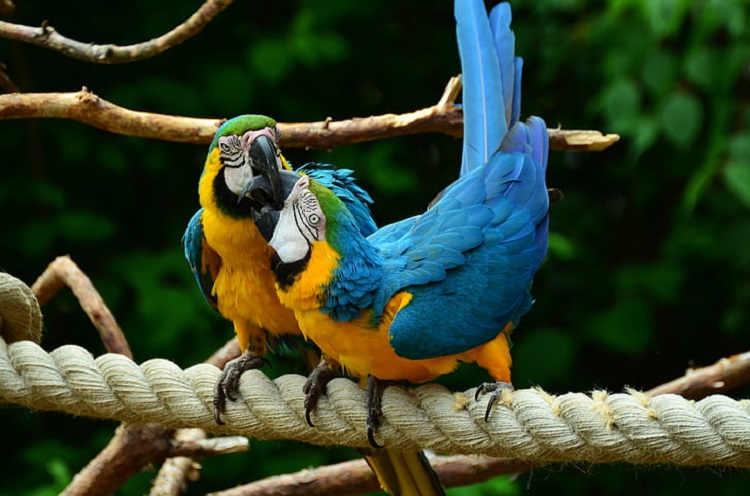
- Hyacinth
- Lear’s, also known as the Indigo
- Glaucous
- Spix’s
- Blue and yellow, also known as the Blue and Gold
- Blue-throated
- Military
- Great green, also known as Buffon’s
- Scarlet
- Red and green, also known as the Green-winged
- Severe, also known as the Chestnut-fronted
- Red-fronted
- Cuban red, which is now extinct
- Saint Croix, which is now extinct
- Red-bellied
- Blue-headed
- Blue-winged, also known as Illiger’s
- Golden-collared, and the
- Red-shouldered, also known as Hahn’s macaw
Macaw Extinct Species Hypothetically
In addition to the 17 species of macaw found today, some have proposed that five additional species of macaw that are now extinct also existed.
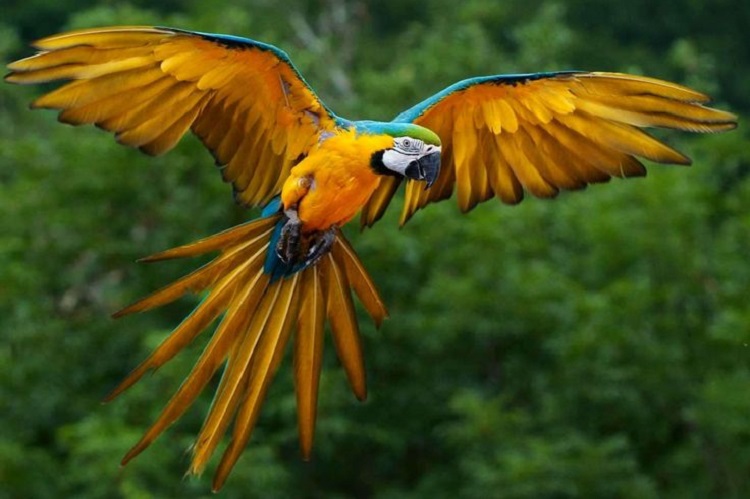
However, there is very little evidence to support this theory. The birds in question were:
- Martinique macaw
- Lesser Antillean macaw
- Jamaican green-and-yellow macaw
- Jamaican red macaw and the
- Dominican green-and-yellow macaw
Macaw Hybrids
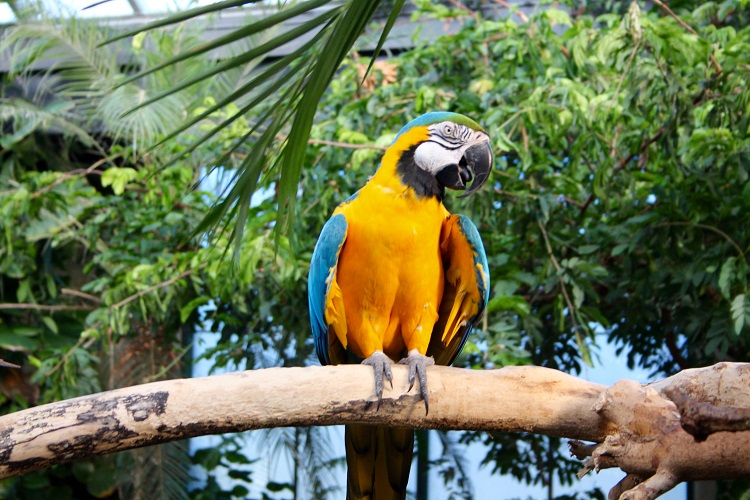
Today due to the demands in the pet trade, some macaw species have been crossed, resulting in a hybridized species.
And although technically speaking, they are still part of the same genus, these are not pure species Macaws and are referred to as first, second, or third-generation hybrids.
Among some of the more common crossings are the Harlequin (Blue-and-Yellow macaw crossed with the Red-and-Green macaw) and the Miligold macaw (Blue-and-Yellow macaw crossed with the Military macaws)
Since then, more than 35 different macaw hybrids have occurred, with 16 second-generation hybrids, such as the Miliquin macaw, a crossing of the Harlequin macaw and the Military macaw (Ara militaris), and five hybrids of third-generation macaws.
Scarlet Macaw and the Blue and Gold Macaw
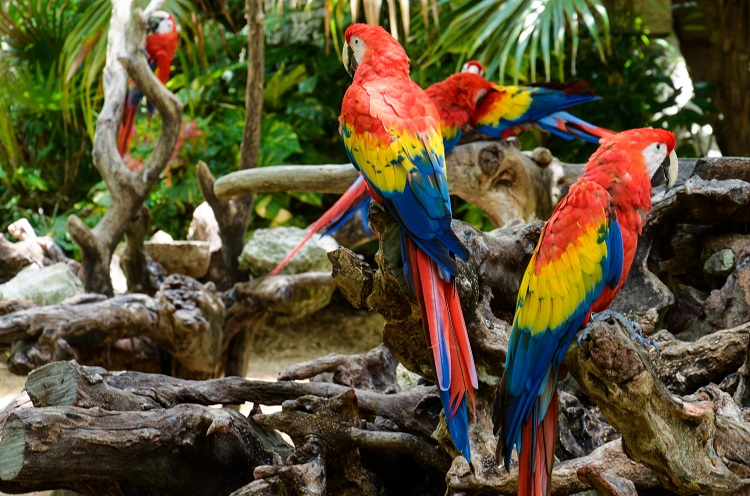
Interestingly the cross between the Blue and Gold macaws (Ara ararauna) and the Scarlet macaw, known as the Catalina or the Rainbow in Australia, came about when the hybrid species was first produced in captivity in 1940.
And there is even speculation that this bird was the first hybrid macaw. However, breeders back then selected the Blue and Gold macaw (Ara araraun) for its friendly nature.
Then, they crossed it with the Scarlet macaw (Ara macao), known for its striking beauty, and created the much sought-after Catalina hybrid seen today.
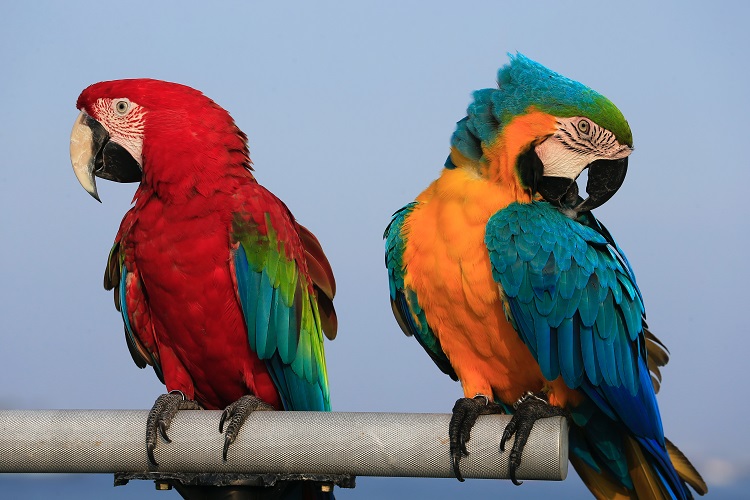
Are Macaws Endangered?
Sadly, some macaw species found in the wild today are now considered endangered, with some even at risk of extinction.
As such, the Spix’s macaw is thought to be extinct in the wild, as is the Glaucous macaw, with only two records of its sightings in the twentieth century.
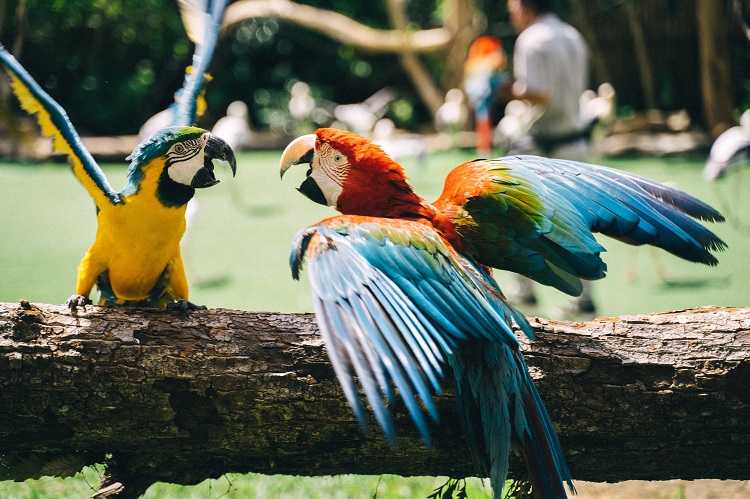
But interestingly enough, the Spix’s macaw could be making a comeback after all these years after being considered extinct in the wild since 2000.
For years conservation efforts by the Brazilian government and NGO agencies have worked tirelessly to breed a new population of Spix’s macaws with the plan to reintroduce this species back into the wild.
But other species of macaws at the greatest risk of extinction are the Great Green macaw (Ara ambiguus) from northern Colombia and the Blue-throated macaw (Ara glaucogularis) from Bolivia.
Macaw Diet
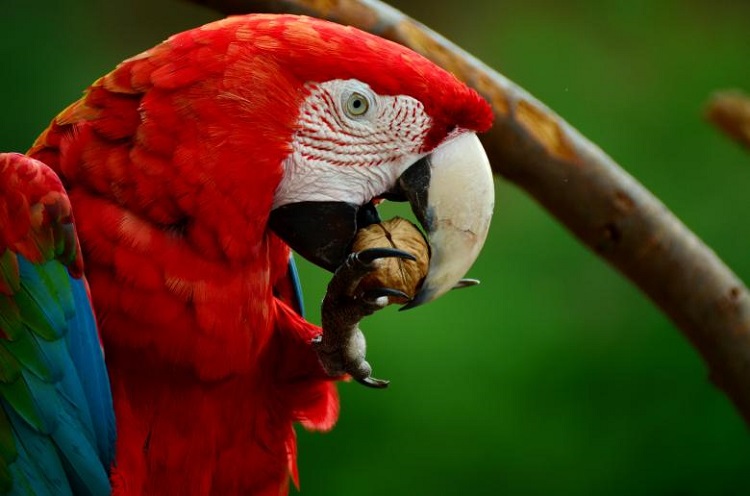
Macaws have been known to fly up to 62 miles a day in search of seasonally rich feeding grounds, and typically, this bird species will forage twice a day for food, in the morning and afternoon.
As such, a macaw’s diet consists of foods including fruits, leaves, flowers, seeds, nuts, palm fruits, and protein sources such as snails and insects.
And talking of palm tree nuts, this bird has a helpful trick that it utilizes to great effect. Often you will find these birds foraging in fields where cattle live.
The reason; cattle eat palm nuts which then pass through their digestive system and are excreted with the nut’s hard coating removed. The macaw then moves in as the nuts are now softer and easier to eat.
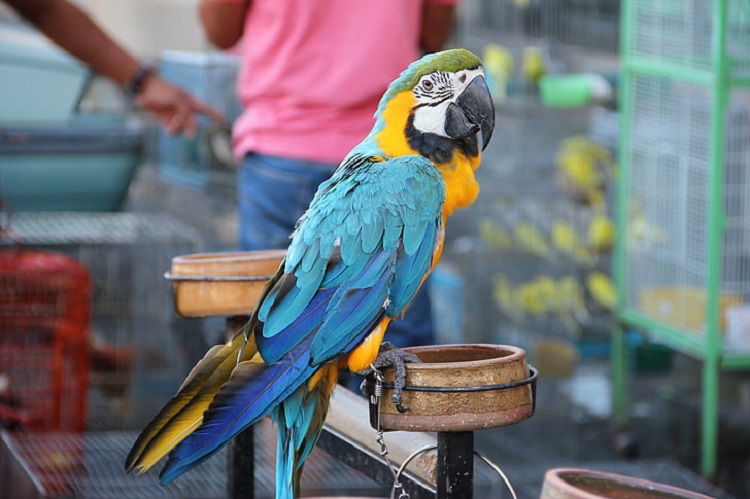
Interestingly macaws only in the Amazon basin visit exposed river banks where they eat clay with these sites known as a clay lick.
One theory for this is that macaws eat some foods that contain caustic or toxic substances which they are unable to digest, and it is thought that by eating the clay, these toxins are then neutralized in the bird.
However, more recent research has put forward that the reason for this behavior by macaws is more to do with the birds’ sodium and vitamin B12 requirements during the breeding season.
Family Life Macaws
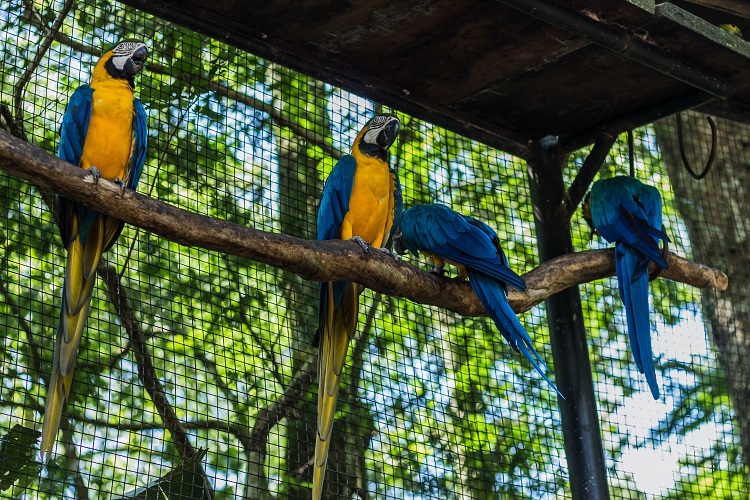
Noisy, raucous, curious, and intelligent, macaws like to explore and keep busy.
And as social birds, they spend a good amount of time in the wild interacting with their family groups.
And when not foraging for food, this bird has been known to examine and play with items it found by moving the object around with its feet or testing it out with its tongue.
Macaws are also renowned chewers and are known for the impressive damage they can do to hardwood with their curved beaks.
But it is their raucous screaming, which is the natural call for the macaws to contact one another, whether as a warning or in play, that they are best known for.
Macaw Rainforest Adaptations
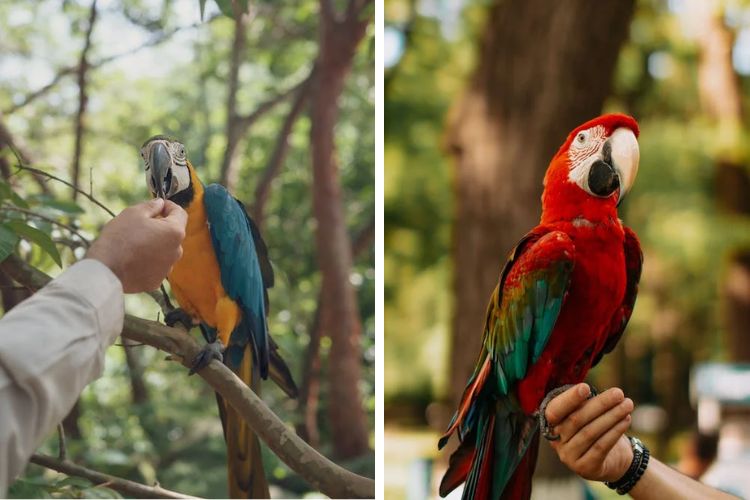
The colorful and vibrant plumage of the macaw makes it a bird well suited to life in the Central and South American rainforests with its colorful flowers and fruits, blue shadows, and green forest canopy, where this species blends in well.
In fact, macaws are designed for flying through the trees of a forest with wings that don’t flap, deeply streamlined bodies, and long graceful tails.
With their powerful beaks, these birds are well adapted to easily crack nuts and seeds and use their dry, scaly tongues with the bone inside to tap into fruits in the rainforest.
Additionally, macaws have gripping toes, which they use to latch onto branches and examine things.
Macaws Behavior
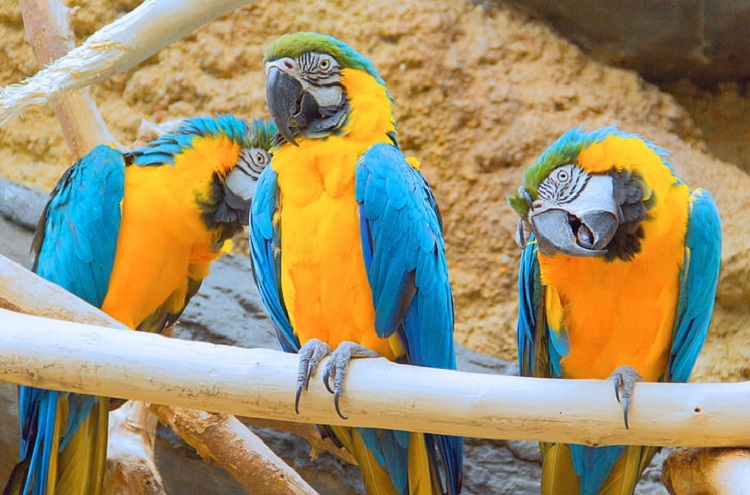
Macaws tend to gather in a large flock of 10 to 30 birds at a time and use their loud squawks and screams to communicate within their flock, mark their territory and identify one another.
In fact, after a day of foraging for food, when macaws return to their roosting site, they will call out to each other to figure out seating arrangements for the night.
Reproduction
Most macaws nest in earthen banks, cliff sides, or holes in trees, with most typically choosing a mate for life.
This close relationship, referred to as a pair bond, is reinforced as the two birds enjoy mutual grooming of each other’s feathers, roosting together, and sharing food.
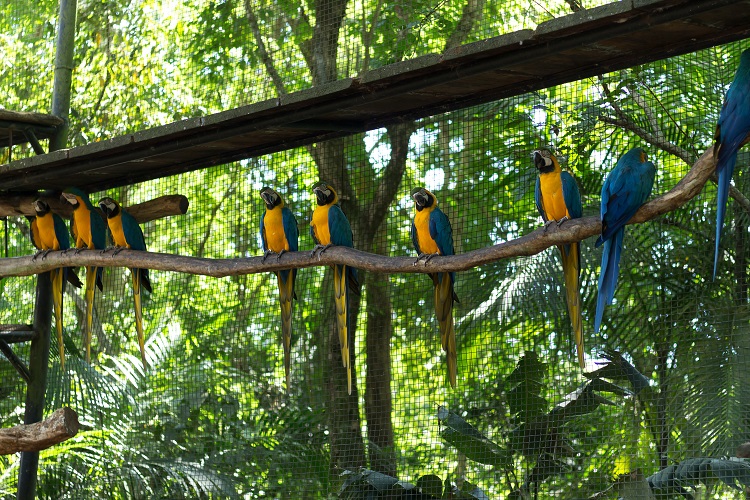
In fact, the bond is so strong that when the pair fly in a flock together, the two fly with their wing almost touching. How adorable!
Macaw pairs breed once a year, with the female laying between one to four eggs and incubating them for up to 30 days. During the incubation period, the male is in charge of bringing the female food until the macaw chicks hatch.
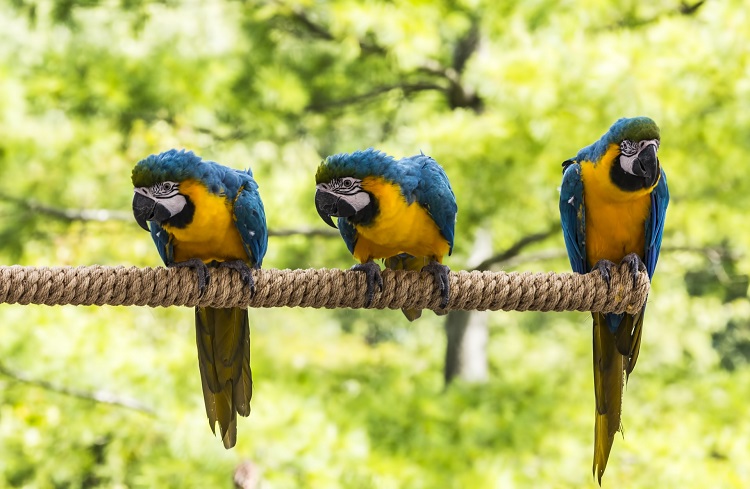
After hatching, the fledglings are helpless, and their eyes remain shut for a couple of days. Initially covered in downy feathers, their plumage only comes in at about ten weeks of age.
Clumsy at first, the fledgling learns to fly at about three months of age, where they will learn how to forage for food with the other members of the flock.
Facts About Macaws
Did you know that large macaws’ beaks are so strong that they are estimated to have the bite strength of a large dog bite.
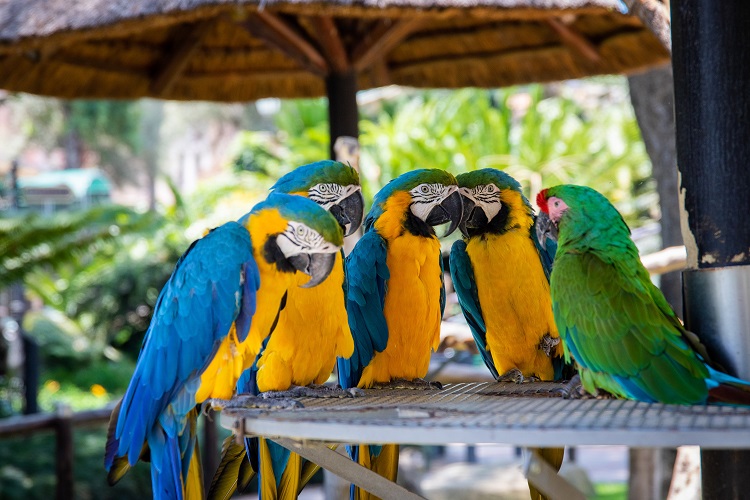
Here are some other interesting facts about these bright and colorful birds.
- Hyacinth macaws, the largest macaws and the largest parrot in the world by length have a wingspan of more than four feet.
- Macaws can imitate sounds and mimic human speech if they live near humans. Often these birds will repeat words they hear and practice them until they get them right.
- The Red-fronted macaw (Ara rubrogenys) can fly nearly 40 miles an hour.
- The average lifespan of a macaw is about 60 years, but with the right conditions, these birds can live up to a hundred years of age.
Relations With Humans
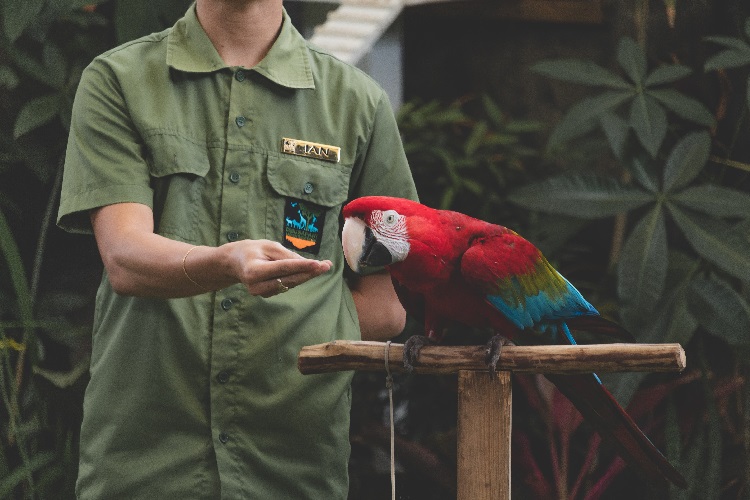
Macaws and their brightly colored plumage have long attracted the attention of humans throughout history.
In fact, the bright colors of the macaw feathers were highly desired by pre-Colombian civilizations such as the Wari, Inca, and Nazca, and they were often used as adornments at burial and ceremonial sites.
In addition, South American weavers also used the macaw’s feathers to create feathered panels and tabards.
And then there is the pet trade, wherewith their ability to talk and showstopping plumage; the macaw became a sought-after show bird as a pet.
Conservation Status of Macaws
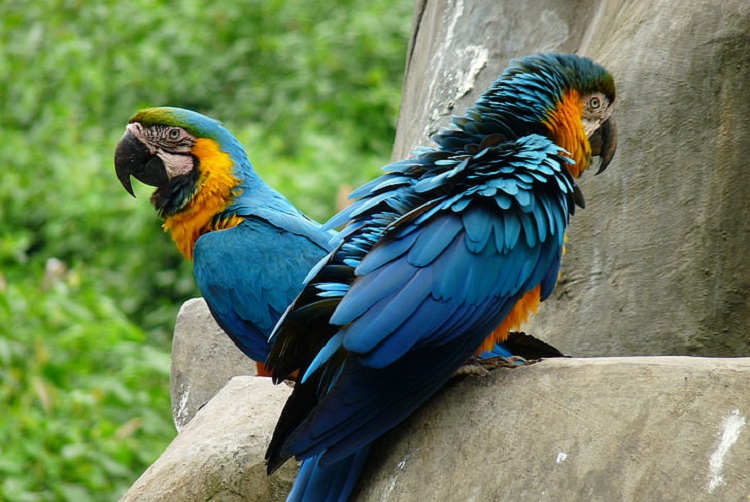
Sadly it is due to human activities such as logging, farming, the erasing of their natural habitat for development, and the illegal trapping for the bird trade that has led to the decline in macaw numbers.
In fact, several macaw species are now listed as endangered or at critical risk, while some have become extinct altogether in their natural habitat.
For example, the Lear’s macaw is found only in a small area in northeastern Brazil and depends largely on the nuts of the licuri palm for food.
Unfortunately, large tracks of this palm forest have been cleared, thus reducing the natural habitat for this species. As such, the Convention on International Trade in Endangered Species of Wild Flora and Fauna currently regulates all species of macaws.
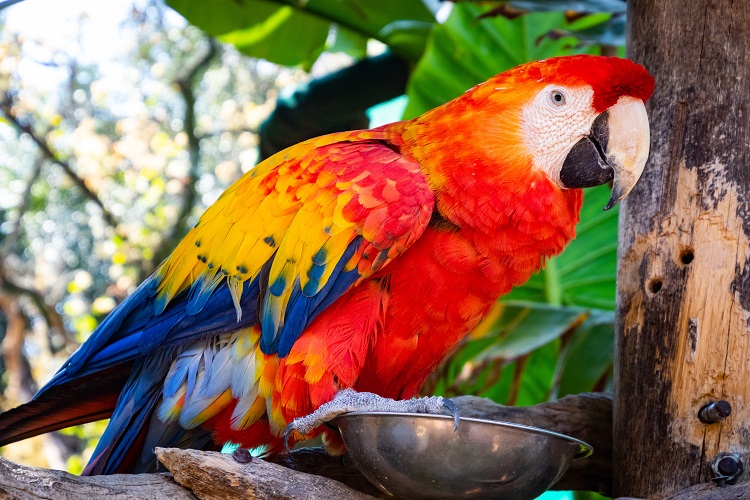
The Scarlet macaw, for example, has been listed by CITES as, by law, not to be traded for commercial purposes. While in comparison, the Red-Shouldered macaw may be legally traded with certain conditions attached to the trade.
Yet the illegal trade of the macaw birds continues, with conservationists of the birds adopting different strategies, such as using tourist fees to buy up protected areas of forest or offering local inhabitants money to leave the critically endangered birds and their habitats alone.
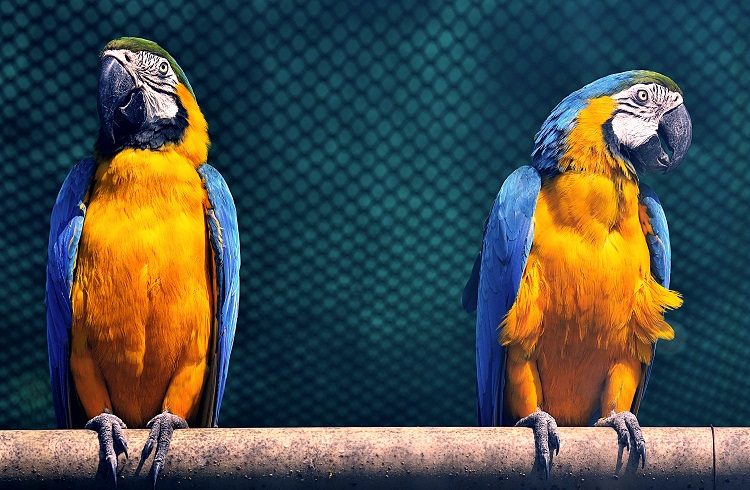
FAQ’s
Why Are Macaws Endangered?
Chief contributors to macaws being declared endangered are the destruction of their natural habitat due to deforestation, illegal trafficking, and the persecution of these birds by farmers when protecting their crops.
Are Macaws Herbivores?
Macaws are omnivores which means they are not strictly herbivores or carnivores. Instead, they are opportunistic eaters and will consume both plants and animals.
How Many Genera Does the Macaw Have?
The macaw has six genera, Anodorhynchus, Ara, Cyanopsitta, Orthopsittaca, Primolius, and Diopsittaca.
What Is the Scientific Name of the Scarlett Macaw?
The scientific name of Scarlett Macaws is Ara macao.
Conclusion
Macaws can make great pets, but they are not for novice bird owners.
They require space and lots of it and constant monitoring. As mentioned previously, these birds need a lot of social interaction and socialization, so they don’t get bored.
A bored macaw can make them a force to be reckoned with as they vocalize their frustration and turn to destructive habits such as picking or destroying their feathers and chewing on any wood they find.
These birds require constant care and attention and require pet owners that are up to the task.
But if you think you are up to the task and can handle the responsibilities of owning a macaw, you will have found yourself a feathered companion for life.


